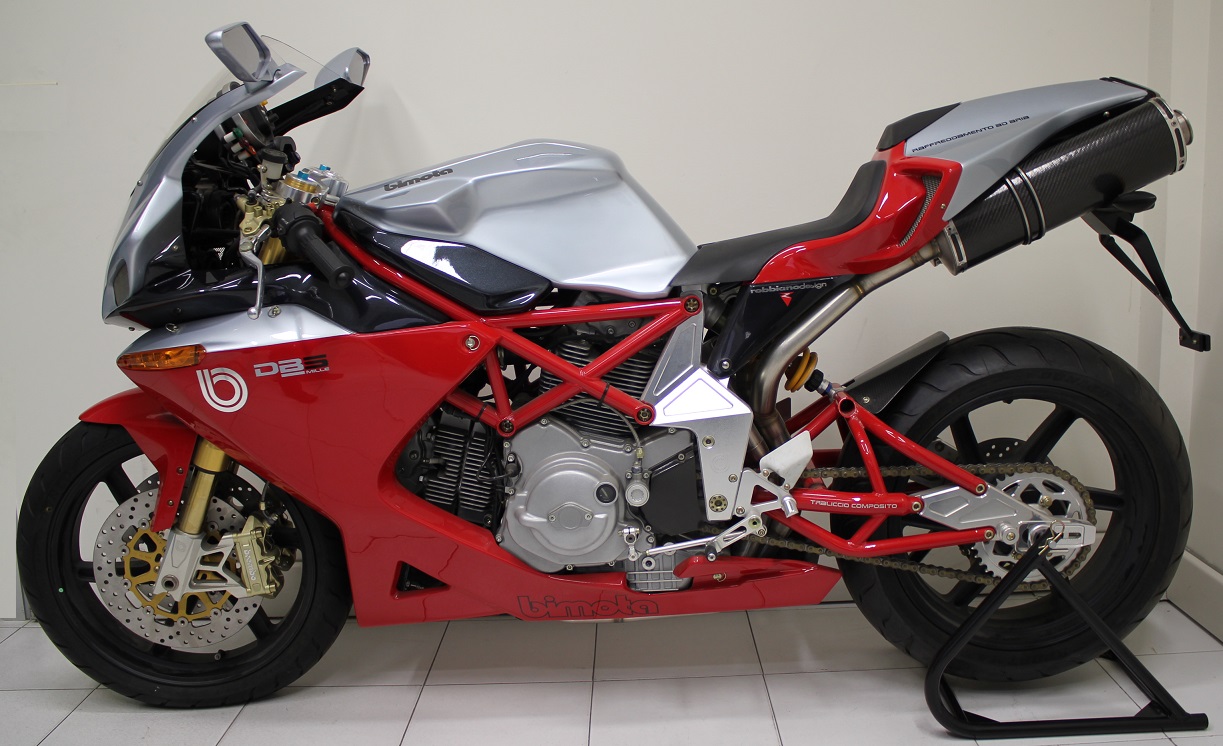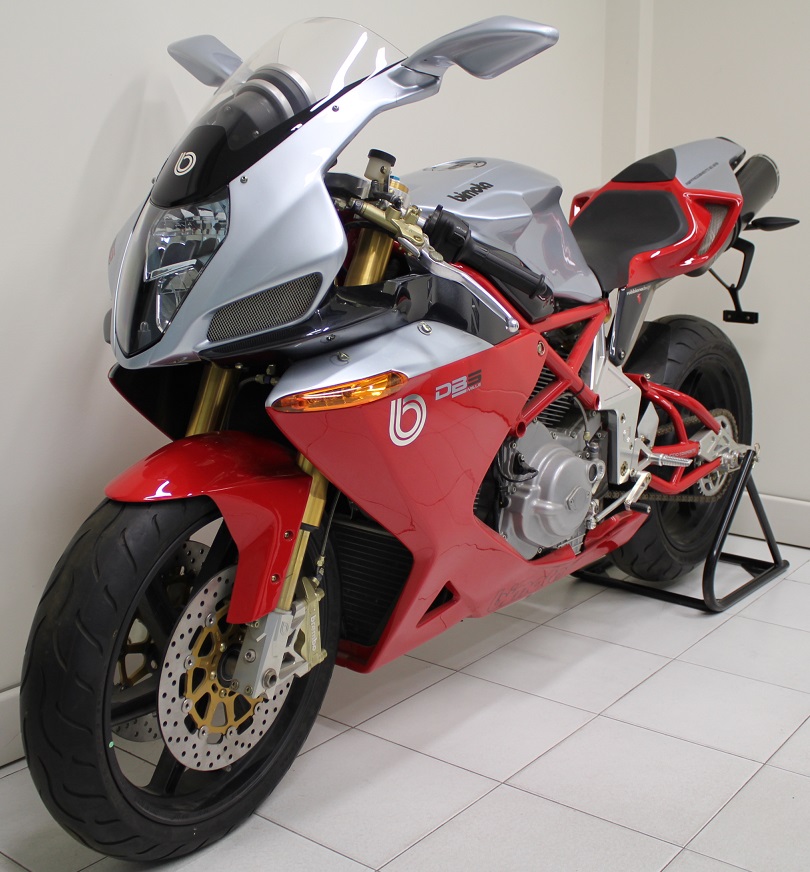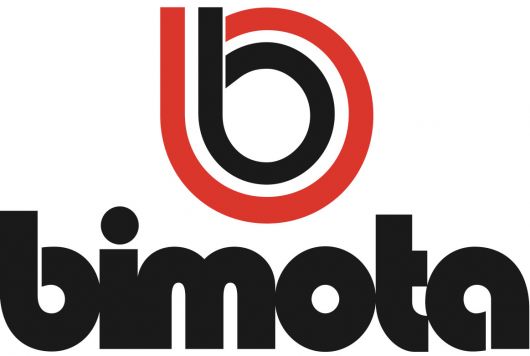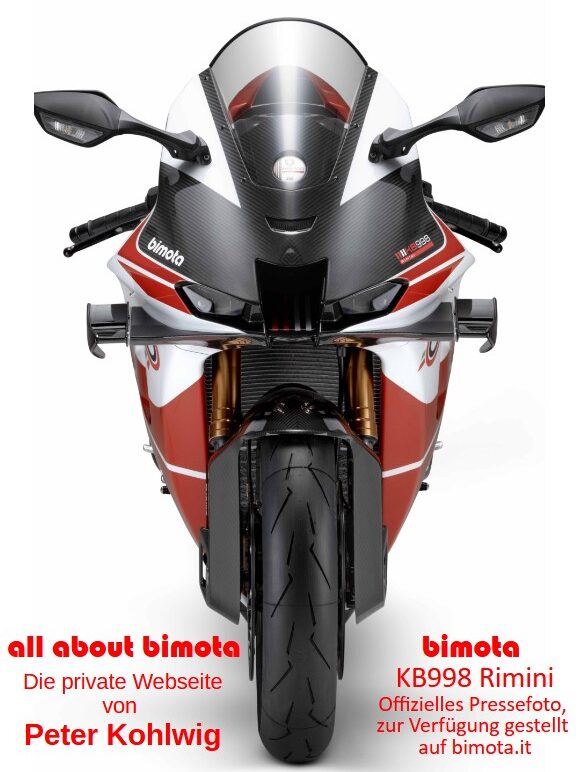
| Designer | Enrico Borghesan (chassis) Sergio Robbiano (body) | Premiere | Munic 2004 |
| Production period | 2004 – 2012 | Production numbers | 234 1000cc 114 1100cc |
| power | 67 KW (92 PS) | Displacement | 992 ccm |
| Topspeed | 225 km/h | Weight | wet 181 kg dry 166 kg |
| Price | 26.900 Euro (2005) | Colours | red / silver |
| Technical basis | Ducati SS 1000 | Multistrada | and Monster |
The first motorcycle that Bimota presented to the public after its new beginning was the DB5 Mille, unveiled at Intermot in Munich in 2004. Featuring a composite frame made of welded chrome-molybdenum tubes and milled aluminum plates, along with a swingarm constructed using the same concept, and a full fairing that does not obscure its remarkable design, the DB5 combines traditional elements into an elegant motorcycle. This design earned it the Motorcycle Design Award in the Supersport category.
At a time when major manufacturers were tuning superbikes to reach 200 horsepower, Bimota took a different approach. The DB5 was launched with the proven 1000cc Ducati engine, also used in the SS, Monster, and Multistrada models. The air-cooled two-valve V2 Desmo engine with dual ignition, optimized by Bimota, produced 92 horsepower. However, with a fully fueled weight of just over 180 kg, the DB5 was even significantly lighter than Japanese 600cc sportbikes. Combined with a chassis geometry designed for agility, this made it an ideal sportbike for winding roads.
The open trellis frame is welded from tubes with diameters of 20 and 25 mm, using the engine as a load-bearing element from below. The swingarm incorporates three different tube diameters—35 mm, 25 mm, and 15 mm. The chassis is completed with the following components:
- Öhlins 43mm USD telescopic fork
- Öhlins central shock absorber
- Brembo braking system
Front: Two floating discs with a diameter of 298 mm and radially mounted four-piston calipers
Rear: Fixed disc with a diameter of 220 mm and two-piston caliper - OZ 6-spoke aluminum wheels
- Front: 3.50 x 17 with 120/70/17 tires
- Rear: 5.50 x 17 with 180/55/17 tires
- Height-adjustable footpeg system
In spring 2005, the German magazine Motorrad tested the DB5 on the Valencia racetrack in Spain and published a report in issue 15 of that year:
„The chassis of the DB5, designed by Tamburini’s student Sergio Robbiano, is impressive across the board. Anyone who has ever ridden a Ducati 998 or 999 knows their unshakable stability. Except for a slightly nervous rear end under hard braking, the DB5 behaves similarly. However, the Bimota reacts very differently when turning. The 66-degree steering head angle, combined with a wheelbase of 1,425 mm, a 100 mm trail, and the bike’s low weight, results in wonderfully light but not overly nervous handling. Once accustomed to the minimal resistance with which the DB5 can be flicked into Valencia’s mostly tight corners at high speed, every change of direction becomes pure enjoyment. It leans in smoothly and precisely, eagerly accepts mid-corner corrections, and provides clear feedback at all times about what is happening at the critical contact patch between the asphalt and the Dunlop tires, which harmonize exceptionally well with the Bimota.
Additionally, the DB5 offers modern ergonomics that provide ample freedom of movement even for riders over 1.80 meters tall. The handlebars are not too low, the tank is short and narrow, and the knee grip is perfect. Only very tall riders might find the distance between the alluringly slim seat and the footpegs (adjustable by 16 mm in height) too small. However, no one will complain about the powerful, precisely controllable brakes or the excellent wind protection when crouched behind the fairing.“

A small side note about the DB5’s headlight: Bimota has often used components from other manufacturers. It was common practice not only to adopt the engine, wiring harness, and controls from a technical donor but also sometimes the lighting. However, the DB5’s front headlight does not come from Ducati but rather from the Suzuki GSX-R1000.
In 2006, Bimota introduced the DB5R, an upgraded variant equipped with lighter, gold-painted forged OZ wheels, a titanium exhaust system from ZARD, larger front brakes with 320 mm discs, a slipper clutch, and carbon fiber fairing parts. As a result, the R version had a dry weight of just 160 kg. Additionally, an improved engine tune provided 5 more horsepower and approximately 10% more torque.
Visually, the „R“ model was distinguished by its green, white, and red livery.
A total of 234 units of the first DB5 series with the 1000cc DS engine were produced, divided into the following models:
- 140 DB5 1000 Monoposto
- 65 DB5 1000 C (a performance-enhanced version with a Motocorse exhaust system)
- 12 DB5 1000 R
- 17 DB5 1000 S Biposto
From 2007 onward, Bimota implemented the next stage of Ducati engine development in the DB5. Instead of 992 cc, the new engine had a displacement of 1,078 cc and produced 90 horsepower in its base configuration. These models can be identified by the „1100“ lettering on the lower fairing.
Until the end of production, 114 more DB5 units were built, divided into the following models:
- 12 DB5 1100 C
- 45 DB5 1100 R
- 46 DB5 1100 S Biposto
- 10 DB5 1100 E „Desiderio“ (from late 2011 with the engine from the 1100 Hypermotard)
- 1 DB5 1100 Borsalino

